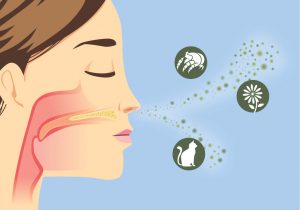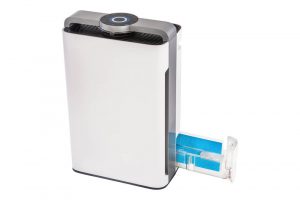There are lots of invisible allergy triggers that exist around us. Suffering from allergies can be frustrating, especially those that experience severe allergy symptoms.
You can deal with indoor allergens in various ways. These methods are easy to perform while ensuring you enjoy long-term relief.
In this article, we explain what an allergy is and what indoor allergens are. We discuss the common triggers that can lead to allergic reactions which will help you to deal with any allergens in your house effectively.
Contents
Key Takeaways
- Allergens in your home, such as dust mites, pet dander, and mould, can trigger allergies and cause symptoms like sneezing and itchy eyes.
- Indoor allergens come from various sources, including pets, carpets, soft furniture, stuffed toys, bedding, damp areas, and indoor plants.
- To reduce indoor allergens, maintain a clean environment by dusting daily, vacuuming regularly, using an air purifier, controlling humidity, preventing pet dander, and addressing mould growth promptly.
What Is an Allergy?
Your immune system defends your body against invaders that it considers threats. The production of antibodies in your blood is geared towards dealing with these threats.
 Your immune system views substances such as pet dander, pollen and dust as threats. These substances are technically harmless, but you can have an allergic reaction to them.
Your immune system views substances such as pet dander, pollen and dust as threats. These substances are technically harmless, but you can have an allergic reaction to them.
Your immune system produces antibodies since it perceives these substances as threats. You’ll experience an allergic reaction such as coughing, itchy and watery eyes, runny nose and sneezing once your immune system goes into overdrive. This is the body trying to fight off what it considers threats.
You can be born with an allergy, or it can develop as you get older. Allergic reactions vary from person to person and mainly depends on the immune system. You may experience allergic reactions throughout the year or during spring and autumn months.
What Size Are Allergens?
Allergens exist in various sizes and are measured in micrometres, also known as a microns. For example, pollen grains are between 10 and 40 microns in size with some pollen grains fragmenting into particles around 1 micron.
What Are the Main Sources of Indoor Allergens?
Pets
Pet dander that falls off pets is an indoor allergen. Long-haired pets may also bring pollen into your home. You may also have an allergen problem if you don’t groom your pet.
Wall-to-wall Carpet
You shouldn’t install a wall-to-wall carpet in a damp area as it may lead to a moisture problem. Allergens can exist on your carpet for a long time.
Soft Furniture
 Allergens such as mould and dust mite may settle on your soft furniture. Your furniture may provide humid environments for dust mites.
Allergens such as mould and dust mite may settle on your soft furniture. Your furniture may provide humid environments for dust mites.
Stuffed Toys
Allergens such as dust mites and dust may be found in stuffed toys. These toys are a significant risk factor for these allergens.
Bedding
Allergens such as pet dander and dust mites may exist in your bedding. Mould may also thrive in bedding.
Damp Areas
Damp environments can lead to the growth of mould. Dust mites also thrive in such conditions.
Indoor Plants
Your indoor plants may be the source of mould in your house. This more so applies to plants that regularly need water. You may also risk pollen allergies by having an indoor plant.
What Are Common Allergy Triggers?
Dust Mites and Dust
Dust is one of the leading causes of allergic reactions. It exists in every place. Symptoms including watery eyes, sneezing and sudden coughing are indicators that you may be suffering from this allergy.
Dust mites live in house dust and they need dust particles to survive. You can find these organisms in your fabric, bedding and drapery. They thrive in humid conditions. However, they can still exist in dry conditions.
Mould
There are thousands of species of mould in existence with mould being another common allergy trigger. It thrives in damp conditions.
Lots of mould species aren’t visible. The spores of such species are incredibly tiny. They can travel through the air, and you can get an allergy once you inhale spores into your respiratory system.
Nitrogen Dioxide
Road traffic and fossil fuels are widely associated with the production of nitrogen dioxide. Certain indoor appliances also can produce this gas.
You risk exposing yourself to nitrogen dioxide if you use a furnace or gas stove at home. Inhaling this gas for a prolonged time can cause lung problems. You may also experience respiratory system irritation.
Pet Dander
Flakes of skin that your pet sheds are known as pet dander. Cats, dogs, birds and rodents shed dead skin daily. Saliva and faeces of your pet also contain pet dander.
The ragged edges of pet dander make it stick nearly everywhere. You can still have pet dander in your house even though you don’t own any pets.
You can pick up pet dander from a friend’s place who owns a pet. Still, you can get this allergen in public places.
How Can I Reduce Indoor Allergens?
Dust Daily
You should take time to wipe down surfaces such as tables and windowsills every day. This helps to deal with dust build-up. You should dust floorboards, blinds, ceiling fans and mouldings every week to remove any dust.
A damp rag or microfibre cloth is ideal for dusting. Don’t use feather dusters to dust your home. They’ll end up spreading dust in your house.
Vacuum
You can do away with allergens such as pet dander by vacuuming your house regularly. Vacuum your carpet twice a month to remove any allergens.
You should clean up the most used room in the house every day if you have any pets. This helps tackle the build-up of allergens.
Buy An Air Purifier
 You can quickly filter the air you breathe in your house by investing in an air purifier. Install the purifier in the most used room. Its series of filters will adequately cycle air within your home.
You can quickly filter the air you breathe in your house by investing in an air purifier. Install the purifier in the most used room. Its series of filters will adequately cycle air within your home.
You can get rid of most allergens by using a HEPA allergy air purifier. This type of purifier can catch most pet dander, mould spores, dust as well as other common allergens. It can prevent you and your loved ones from inhaling allergens.
Reduce Humidity
Dust mites thrive in humid conditions. You should set your humidity levels to below 50%. Lowering the humidity in your house can slow them down. Low humidity levels may even eliminate dust mites.
Prevent Pet Dander
Most doctors recommend that you stay away from pets with fur or feathers if you are allergic to pet dander. One of the ways to prevent these reactions is by not allowing pets into your bedroom. You should also wash the toys and furniture of your hairy friend regularly.
You can reduce allergy symptoms by often brushing and bathing your pet. Don’t groom your pet if you have any pet allergies. Wear a mask if you must.
Pet dander settles on wall-to-wall carpets. Consider replacing this carpet with a low-pile carpet or bare floors.
Reduce Mould
You should always make sure the surfaces in your house are dry. Damp places in your home such as your flooring, bathroom tiles, your air conditioner and windowsills can induce mould growth.
You can use recommended air quality monitors and a dehumidifier to combat mould growth. Clean any wet surfaces and fix all leaks in your house immediately.
Heat Pump Source: Reliable Heating and Cooling Solutions
At Heat Pump Source, we take pride in our unwavering commitment to serving the UK with top-tier HVAC solutions. From the efficiency of heat pumps and the cool relief of air conditioning to the warmth of boilers, radiators, and underfloor heating, our dedicated team is always at the forefront of innovation. We understand the unique needs of every household and business, and we strive to provide dependable health and cooling products and services that are tailored just for you. Ensuring your comfort and satisfaction is our utmost priority. Whether you have questions, need guidance, or require support, we’re always here to assist. Please don’t hesitate to contact us; we’re eager to be of service.
Conclusion
Indoor allergies can be frustrating. You may face a hard time when you have a severe allergy. It would be best if you got rid of allergens in your home regularly. You can go about your day-to-day tasks without worrying about severe allergic symptoms.
About the Author
At Heat Pump Source, our articles are the product of a collaborative effort among a team of highly skilled HVAC experts. Our dedicated professionals, hailing from diverse backgrounds in heating, ventilation, air conditioning, and refrigeration, contribute their extensive knowledge and experience to every piece of content. This multidisciplinary approach ensures comprehensive coverage. Our commitment is to deliver authoritative, reliable, and tailored advice to meet the unique needs of every household and business across the UK.

